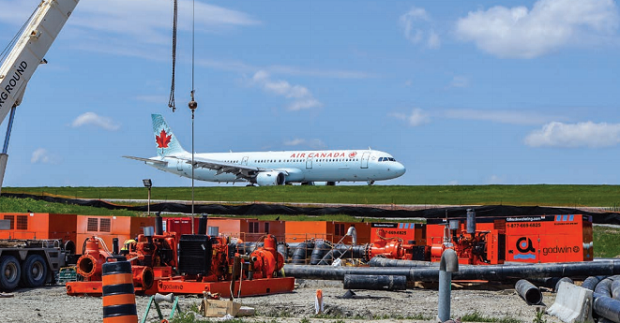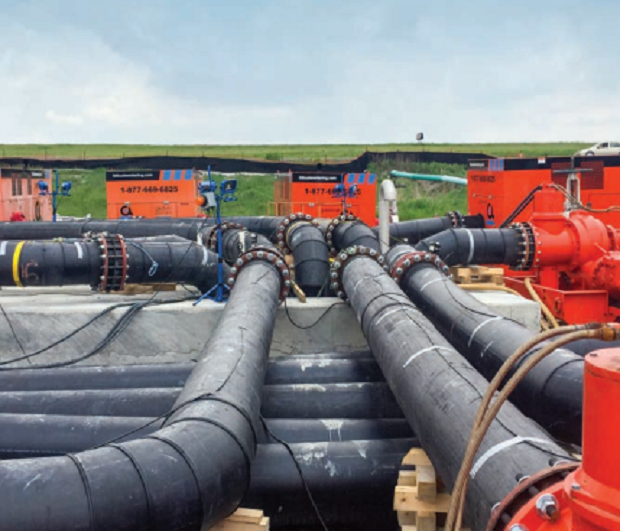Atlas Dewatering Corporation
Massive Sanitary Sewer Bypass Project Completed Under Toronto’s Pearson Airport

The Region of Peel in southern Ontario is home to over one million people and maintains and operates three wastewater treatment facilities, over 30 pumping stations, and 3,500 kilometres of sanitary sewers.
A critical part of this vast network is the Etobicoke Creek Trunk Sanitary Sewer line, which runs under the runways and along the border of Toronto Pearson Airport. To allow ongoing reconstruction and development of its sanitary sewer system, the Region needed to finish a large connection under the runway and implement twinning of the Etobicoke Creek Trunk line for system redundancy. It was a complicated construction project that needed an equally complicated bypass of the existing network.
Adding to the complexity, the entire project had to be done without interruption to airport operations. With over 400,000 flights a year, or roughly one per minute during hours of operation, Toronto Pearson is the busiest and largest airport in Canada.
For this project, the Region contracted Hatch Mott MacDonald, CRS Tunneling, Inc. and Dibco Underground, Ltd. Atlas Dewatering Corporation was brought in to spearhead the complex bypass effort, using Xylem’s Godwin and Flygt pumps.
NEVER TOO SAFE
The Etobicoke Creek Trunk Sanitary Sewer line handles flow from the City of Mississauga, the City of Brampton, and Toronto Pearson Airport. With wastewater influx from over a million people, flow rates in the line average 190-285 million
litres per day (MLD). To ensure bypass capabilities that could handle a severe wet weather event, Atlas designed a bypass with 400 MLD capacity.
LET IT FLOW
The primary 1,800 mm sanitary sewer line at Etobicoke Creek feeds into a 1,200 mm and a 1,650 mm line, via a splitting chamber. As part of the reconstruction effort, each of these lines had to be diverted and accessed, to be able to upgrade the valves, do some manhole work, and tie them in to the new twinned sewer line and chambers.
Phase I of the bypass project began on March 15, 2016, and involved plugging the 1,200 mm line, to provide access for work crews. The Atlas team, using an inflatable, mechanical dome style sewer plug, air hose and air regulator, diverted flow from the 1,200 mm line to the 1,650 mm line. The plug was in place for approximately 30 days, and the bypass was completely manual and gravity fed, with no pumps or piping necessary. As the 1,650 mm line was large enough to handle the temporary increased flow, Phase I went off without issue.
Phase II of the bypass project was to block off and bypass the 300 metres of the 1,650 mm line, so the team could have access for reconstruction efforts. Similar to the Phase I bypass, the Atlas team installed an inflatable, mechanical plug, which diverted flow from the 1,650 mm line back to the 1,200 mm line. As with Phase I, this was also a completely manual, gravity-fed bypass.
However, since there was potential for the increased flow from the larger line to overwhelm the smaller 1,200 mm line (given a severe weather event), Atlas incorporated a back-up scenario into the bypass plan. If necessary, they could bring in upwards of four Godwin diesel-driven critically silenced CD400M pumps to handle the extra flow.
On April 12, immediately after Phase I was completed, the plug was inserted into the 1,650 mm line and Phase II of the bypass was underway. It too ran for approximately 30 days without a hitch, or any severe weather event. The back-up plan never needed to be implemented, saving Peel a significant amount of money.

ONE PUMP AND ONE PIPE AT A TIME
To handle the 323 MLD of flow in the primary 1,800 mm trunk line during the final phase of the bypass, Atlas brought in 11 Godwin diesel-drive critically silenced CD400M pumps with 450 mm capacity, to be rented by Peel during the bypass operation. Ten of them would be utilized as the primary pumping mechanism, with the eleventh as a back-up. To save energy and diesel fuel costs, each pump was set up with a Godwin level transducer, with floats in place that would trigger the diesel pumps on and off, depending on predetermined flow levels. The bypass design was set up so that the pumps would start sequentially, only turning on as increased system flows called for additional pumping.
With the length of the bypass at around 85 metres, approximately 1,000 metres of 450 mm HDPE pipe was rented. Each pump had a dedicated suction line and dip tube, as well as a discharge line, and could handle flow of approximately 38 MLD. On May 24, after two weeks of round-the-clock work on installation, the gates at MH1 were closed off and the flow was diverted to the upgraded lines downstream, thus beginning Phase III. During lower flow, a minimum of three pumps were running during the bypass. As many as eight pumps would run during higher, peak-flow activity, with pumps nine and ten in place to handle any extreme weather event flow.
For each phase of the bypass, all discharge lines were pressure-tested and a leakage test using clean water was performed prior to start up, to ensure the system was watertight. Phase III ran non-stop for six days. For additional security, a full time pump watch duty was put in place, to address any issues with the systems in place, and to ensure immediate resolution of any problems.
AT THE AIRPORT, AND ON TIME
The comprehensive bypass effort for the Etobicoke Creek Trunk Sanitary Sewer Line took place on airport property, only
metres away from runways, taxiways and access roads. This made it that much more complex for the work crews. Over the course of the project, workers from all teams had to obtain daily clearance with airport security, before being allowed onto the premises.
Once at the job site, all equipment and construction crews had to maintain strict distance requirements to adhere to airport protocol. An eight-metre runway object-free area had to be maintained at all times, to ensure the safety of the teams on the ground. They were also in constant communication with airport personnel, as the airport couldn’t shut down at any time during the construction and bypass project.
Adhering to a tight schedule, the Atlas and Xylem teams were able to set up and break down the bypass operation in less time than was spelled out in the original plan. All in all, each phase of the bypass ran without a problem over the course of11 weeks. It was a turn-key solution that helped the Region of Peel integrate the upgrades that needed to be made, in a timely and efficient manner.
What initially just looked like a very complex project, ended up being the largest sanitary sewer bypass project in Canada, all within the confines of its largest airport.
Source: https://atlasdewatering.com/wp-content/uploads/Click-Here-for-link-to-article-Massive-Sanitary-ByPass-2016.pdf

|